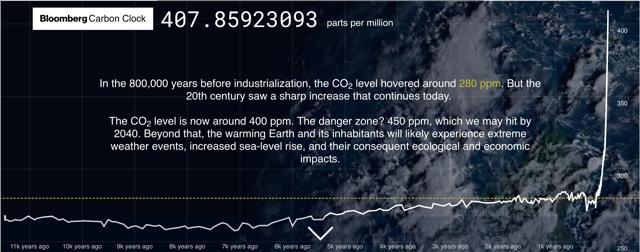
Jan Dash PhD is a physicist, an expert at quantitative finance and risk management, and a consultant at Bloomberg LP. In his thought-provoking book, Quantitative Finance and Risk Management, A Physicist’s Approach, he devotes a chapter to climate change and its long-term systemic risk. Jan’s Climate Portal provides background.
In this interview with Phil Stock World’s editor Ilene Carrie, Jan discusses climate change and the way inaction is threatening our future.
Ilene: Hi Jan. Thank you for taking the time to share your ideas on global warming. . . I’m looking at a graph, along with the current atmospheric CO2 level that you and Yan Zhang modeled for the Bloomberg Carbon Clock, which shows just how sharply CO2 levels have increased mostly in only the last 50 years relative to the last 12 thousand years. And I can see that CO2 levels are currently about 400 ppm – and that at 450 ppm, the text says we will reach a “ danger zone.” What happens when CO2 levels reach 450 ppm? Why is that level considered the “danger zone?”

Screenshot of Bloomberg Carbon Clock
Jan: If we can limit CO2 to 450 ppm, it is likely that we can limit the average global temperature increase to around 2 degrees Centigrade or 3.6 degrees Fahrenheit above pre-industrial levels. This is the goal of the Paris Agreement, designed to leave a livable planet to our descendants.
Ilene: Do you think we will be successful?
Jan: With present policies, it does not look like we will achieve that goal. Action must be increased urgently to avoid increasingly severe climate impacts on our grandchildren and their descendants. Solving the climate problem is prerequisite to any long-term solution to the many serious issues facing humanity today. Climate change is actually the outstanding moral, ethical, and survival issue of our time.
We are in a “ danger zone” now. Today’s CO2 level of around 400 ppm is going up rapidly and is already above CO2 levels since the beginning of civilization. The average global temperature is moving out of the stable balanced range that made civilization possible. The present increase in CO2 is outside of natural variation and this extra CO2 can be shown by rigorous physics analysis to be due to human activity, mostly burning fossil fuels. Future climate impacts mostly depend on what we do or don’t do to limit CO2 from burning fossil fuels.
We are now starting to see the effects of climate change (in statistical terms, the signal of climate change impacts is now apparent). Some of the impacts have already been very bad and out of statistics for natural variability. The effects so far, however, are only a small echo of the increasingly severe impacts our grandchildren will experience if we do not act substantially to mitigate climate change now.

Heron by Gellinger/Pixabay
Ilene: If we fail to get CO2 under control, what will the earth be like in the second half of the century?
Jan: We have always had disasters. Climate change makes them worse. Long-term climate impacts in the absence of action will include increasingly severe food and water shortages worldwide, climate-induced migrations due to rising sea levels that will make many coastal cities and regions unlivable, increasingly negative health impacts, increasing extreme weather, increasing political and military instabilities with potentially increased terrorism, increasingly damaged valuable ecosystems, more extinctions of species, and a whole host of other bad impacts. The US military has been writing for years about climate change negatively impacting US national security.
How increases in CO2 raise the average global temperature, what likely risks will follow, and what we can do to lessen those risks are all presented in comprehensive reports. The Intergovernmental Panel on Climate Change (IPCC) volumes run several thousand pages. I get reports every week from reputable universities and laboratories worldwide detailing the increasing dangers of climate impacts.
The real question is what legacy are we choosing to leave our grandchildren – will they have a decent way of life or will they have to deal with massive climate problems? We actually do not have a choice about finding climate solutions if we want to leave a livable world to our descendants. We should think in a risk-management framework.
.

This image was taken in Ulm, Germany, when the river Danube (Europe’s second longest river) caused flood damage following excessive rainfall in June 2013. Hans/Pixabay
Ilene: How do you apply the mathematics of risk management to climate change?
Jan: Climate Change Risk Management is the sensible paradigm that is increasingly being employed to act on climate change. We deal with all sorts of risk. Climate change is a risk. We can deal with the risk of climate change. We have the technology now. Climate risk management is not and does not have to be mathematically precise. We never have complete certainty for anything, and we do not need certainty to act. The analogy I like is that if you are sitting in a car stalled on the railroad tracks, you don’t need to know the exact velocity of the train that is approaching in order to act. The biggest uncertainty is what the human race will or will not choose to do to limit CO2. Climate risk management tools include figuring out corporate climate risk approximately using scenarios, for example the scenarios described by the Task Force on Climate Related Financial Disclosures. Other risk tools include the Social Cost of Carbon and the nascent Climate Change Value at Risk. In my book, I also describe how a formal approach to Climate Change Risk Management can be useful.















